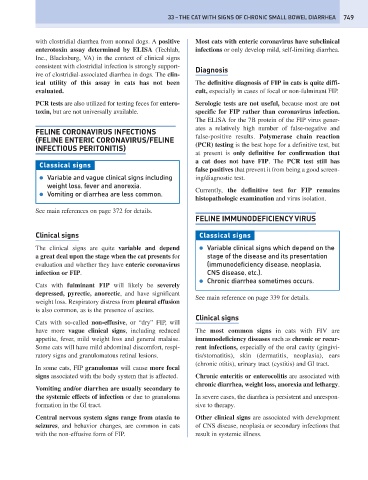Page 757 - Problem-Based Feline Medicine
P. 757
33 – THE CAT WITH SIGNS OF CHRONIC SMALL BOWEL DIARRHEA 749
with clostridial diarrhea from normal dogs. A positive Most cats with enteric coronavirus have subclinical
enterotoxin assay determined by ELISA (Techlab, infections or only develop mild, self-limiting diarrhea.
Inc., Blacksburg, VA) in the context of clinical signs
consistent with clostridial infection is strongly support-
Diagnosis
ive of clostridial-associated diarrhea in dogs. The clin-
ical utility of this assay in cats has not been The definitive diagnosis of FIP in cats is quite diffi-
evaluated. cult, especially in cases of focal or non-fulminant FIP.
PCR tests are also utilized for testing feces for entero- Serologic tests are not useful, because most are not
toxin, but are not universally available. specific for FIP rather than coronavirus infection.
The ELISA for the 7B protein of the FIP virus gener-
ates a relatively high number of false-negative and
FELINE CORONAVIRUS INFECTIONS
(FELINE ENTERIC CORONAVIRUS/FELINE false-positive results. Polymerase chain reaction
INFECTIOUS PERITONITIS) (PCR) testing is the best hope for a definitive test, but
at present is only definitive for confirmation that
a cat does not have FIP. The PCR test still has
Classical signs
false positives that prevent it from being a good screen-
● Variable and vague clinical signs including ing/diagnostic test.
weight loss, fever and anorexia.
Currently, the definitive test for FIP remains
● Vomiting or diarrhea are less common.
histopathologic examination and virus isolation.
See main references on page 372 for details.
FELINE IMMUNODEFICIENCY VIRUS
Clinical signs Classical signs
The clinical signs are quite variable and depend ● Variable clinical signs which depend on the
a great deal upon the stage when the cat presents for stage of the disease and its presentation
evaluation and whether they have enteric coronavirus (immunodeficiency disease, neoplasia,
infection or FIP. CNS disease, etc.).
● Chronic diarrhea sometimes occurs.
Cats with fulminant FIP will likely be severely
depressed, pyrectic, anorectic, and have significant
See main reference on page 339 for details.
weight loss. Respiratory distress from pleural effusion
is also common, as is the presence of ascites.
Clinical signs
Cats with so-called non-effusive, or “dry” FIP, will
have more vague clinical signs, including reduced The most common signs in cats with FIV are
appetite, fever, mild weight loss and general malaise. immunodeficiency diseases such as chronic or recur-
Some cats will have mild abdominal discomfort, respi- rent infections, especially of the oral cavity (gingivi-
ratory signs and granulomatous retinal lesions. tis/stomatitis), skin (dermatitis, neoplasia), ears
(chronic otitis), urinary tract (cystitis) and GI tract.
In some cats, FIP granulomas will cause more focal
signs associated with the body system that is affected. Chronic enteritis or enterocolitis are associated with
chronic diarrhea, weight loss, anorexia and lethargy.
Vomiting and/or diarrhea are usually secondary to
the systemic effects of infection or due to granuloma In severe cases, the diarrhea is persistent and unrespon-
formation in the GI tract. sive to therapy.
Central nervous system signs range from ataxia to Other clinical signs are associated with development
seizures, and behavior changes, are common in cats of CNS disease, neoplasia or secondary infections that
with the non-effusive form of FIP. result in systemic illness.

